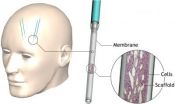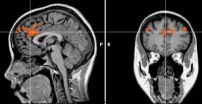(Press-News.org) Amsterdam, NL, June 18, 2012 – Studies suggest that neurotrophic factors, which play a role in the development and survival of neurons, have significant therapeutic and restorative potential for neurologic diseases such as Huntington's disease. However, clinical applications are limited because these proteins cannot easily cross the blood brain barrier, have a short half-life, and cause serious side effects. Now, a group of scientists has successfully treated neurological symptoms in laboratory rats by implanting a device to deliver a genetically engineered neurotrophic factor directly to the brain. They report on their results in the latest issue of Restorative Neurology and Neuroscience.
Researchers used Encapsulated Cell (EC) biodelivery, a platform which can be applied using conventional minimally invasive neurosurgical procedures to target deep brain structures with therapeutic proteins. "Our study adds to the continually increasing body of preclinical and clinical data positioning EC biodelivery as a promising therapeutic delivery method for larger biomolecules. It combines the therapeutic advantages of gene therapy with the well-established safety of a retrievable implant," says lead investigator Jens Tornøe, NsGene A/S, Ballerup, Denmark.
Investigators made a catheter-like device consisting of a hollow fiber membrane encapsulating a polymeric "scaffold," which provides a surface area to which neurotrophic factor-producing cells can attach. When implanted in the brain, the membrane allows the neurotrophic factor to flow out of the device, as well as allowing nutrients in. Dr. Tornøe and his colleagues used the neurotrophic factor Meteorin, which plays a role in the development of striatal projection neurons, whose degeneration is a hallmark of Huntington's disease. The scientists engineered ARPE-19 cells to produce Meteorin and used those that produced high levels of Meteorin in their experiment.
The EC biodelivery devices were implanted in the brains of rats followed by injection with quinolinic acid (QA), a potent neurotoxin that causes excitotoxicity, a component of Huntington's disease. They tested three different implant types: devices filled with the high-producing ARPE-19 cells (EC-Meteorin), devices with unmodified ARPE-19 cells (ARPE-19), and devices without cells. Motor dysfunction was tested immediately prior to injection with QA and at two and four weeks after injection.
The research team found that the EC-Meteorin devices significantly protected against QA-induced toxicity. Rats with EC-Meteorin devices manifested near normal neurological performance and significantly reduced loss of brain cells from the QA injection compared to controls. Analysis of the Meteorin-treated brains showed a markedly reduced striatal lesion size. The EC biodelivery devices were found to produce stable or even increasing levels of Meteorin throughout the study. Meteorin diffused readily from the biodelivery device to the striatal tissue.
"Huntington's disease can be diagnosed with high accuracy by genetic testing. Pre-symptomatic administration of a safe therapeutic treatment providing sustained delay or prevention of disease would be of great benefit to patients," says Dr. Tornøe. "With additional functional and safety data, tests in animals larger than the rat to study distribution, and more accurate disease models to evaluate the therapeutic potential of Meteorin, we anticipate that EC biodelivery can be developed as a platform technology for targeted therapy in patients with Huntington's disease."
INFORMATION:
Device implanted in brain has therapeutic potential for Huntington's disease
New approach reported in Restorative Neurology and Neuroscience
2012-06-19
ELSE PRESS RELEASES FROM THIS DATE:
Link between vitamin C and twins can increase seed production in crops
2012-06-19
RIVERSIDE, Calif. — Biochemists at the University of California, Riverside report a new role for vitamin C in plants: promoting the production of twins and even triplets in plant seeds.
Daniel R. Gallie, a professor of biochemistry, and Zhong Chen, an associate research biochemist in the Department of Biochemistry, found that increasing the level of dehydroascorbate reductase (DHAR), a naturally occurring enzyme that recycles vitamin C in plants and animals, increases the level of the vitamin and results in the production of twin and triplet seedlings in a single seed.
The ...
Research breakthrough: High brain integration underlies winning performances
2012-06-19
Scientists trying to understand why some people excel — whether as world-class athletes, virtuoso musicians, or top CEOs — have discovered that these outstanding performers have unique brain characteristics that make them different from other people.
A study published in May in the journal Cognitive Processing found that 20 top-level managers scored higher on three measures — the Brain Integration Scale, Gibbs's Socio-moral Reasoning questionnaire, and an inventory of peak experiences — compared to 20 low-level managers that served as matched controls. This is the fourth ...
This is your brain on no self-control
2012-06-19
New pictures from the University of Iowa show what it looks like when a person runs out of patience and loses self-control.
A study by University of Iowa neuroscientist and neuro-marketing expert William Hedgcock confirms previous studies that show self-control is a finite commodity that is depleted by use. Once the pool has dried up, we're less likely to keep our cool the next time we're faced with a situation that requires self-control.
But Hedgcock's study is the first to actually show it happening in the brain using fMRI images that scan people as they perform self-control ...
Million year old groundwater in Maryland water supply
2012-06-19
A portion of the groundwater in the upper Patapsco aquifer underlying Maryland is over a million years old. A new study suggests that this ancient groundwater, a vital source of freshwater supplies for the region east of Washington, D.C. and Baltimore, was recharged over periods of time much greater than human timescales.
"Understanding the average age of groundwater allows scientists to estimate at what rate water is re-entering the aquifer to replace the water we are currently extracting for human use," explained USGS Director Marcia McNutt. "This is the first step ...
Anti-cocaine vaccine described in Human Gene Therapy Journal
2012-06-19
New Rochelle, NY, June 18, 2012—A single-dose vaccine capable of providing immunity against the effects of cocaine offers a novel and groundbreaking strategy for treating cocaine addiction is described in an article published Instant Online in Human Gene Therapy, a peer-reviewed journal from Mary Ann Liebert, Inc. (http://www.liebertpub.com) The article is available free online at the Human Gene Therapy website (http://www.liebertpub.com/hum).
"This is a very novel approach for addressing the huge medical problem of cocaine addiction," says James M. Wilson, MD, PhD, Editor-in-Chief, ...
Doctors cite concern for patients, colleagues top motives for working sick
2012-06-19
An unwavering work ethic is a hallmark of many health professionals. But a new survey finds that when a doctor is sick, staunch dedication can have unintended consequences.
A poll of 150 attendees of an American College of Physicians meeting in 2010 revealed that more than half of resident physicians had worked with flu-like symptoms at least once in the last year. One in six reported working sick on three or more occasions during the year, according to the survey conducted by researchers at the University of Chicago Medicine and Massachusetts General Hospital. Notably, ...
Canadian teen moms run higher risk of abuse, depression than older mothers
2012-06-19
(Edmonton) Teen mothers are far more likely to suffer abuse and postpartum depression than older moms, according to a study of Canadian women's maternity experiences by a University of Alberta researcher.
Dawn Kingston, an assistant professor in the Faculty of Nursing, analyzed data from the Maternity Experiences Survey, which asked more than 6,400 new mothers about their experiences with stress, violence, pre- and postnatal care, breastfeeding and risky behaviour like smoking and drug use before, during and after pregnancy.
Kingston said the survey offers the first ...
Understanding faults and volcanics, plus life inside a rock
2012-06-19
Boulder, Colo., USA – This posting: Orange-like rocks in Utah with iron-oxide rinds and fossilized bacteria inside that are believed to have eaten the interior rock material, plus noted similarities to "bacterial meal" ingredients and rock types on Mars; fine-tuning the prediction of volcanic hazards and warning systems for both high population zones and at Tristan da Cunha, home to the most remote population on Earth; news from SAFOD; and discovery in Germany of the world's oldest known mosses.
Biosignatures link microorganisms to iron mineralization in a paleoaquifer
Karrie ...
Psoriasis increases risk of diabetes, Penn study shows
2012-06-19
PHILADELPHIA - Psoriasis is an independent risk for Type 2 Diabetes, according to a new study by researchers with the Perelman School of Medicine at the University of Pennsylvania, with the greatest risk seen in patients with severe psoriasis. Researchers estimate that an additional 115,500 people will develop diabetes each year due to the risk posed by psoriasis above and beyond conventional risk factors. The research is published in the latest issue of the Archives of Dermatology, a JAMA Network publication.
"These data suggest that patients with psoriasis are at increased ...
Cheaper drug could lead to serious eye issues
2012-06-19
A Queen's University study of two eye drugs used to treat wet Age-related Macular Degeneration (AMD) has determined the cheaper of the two could lead to eye inflammation, a potentially blinding adverse effect.
"This is a very important finding," says Sanjay Sharma (Ophthalmology and Epidemiology), a noted AMD and health policy researcher who also practices at Hotel Dieu Hospital. "It is particularly important because many seniors need numerous injections so the risk is cumulative."
AMD is the leading cause of severe visual loss and blindness in Canada. It is linked to ...
LAST 30 PRESS RELEASES:
Fires could emit more air pollution than previously estimated
A new way to map how cells choose their fate
Numbers in our sights affect how we perceive space
SIMJ announces global collaborative book project in commemoration of its 75th anniversary
Air pollution exposure and birth weight
Obstructive sleep apnea risk and mental health conditions among older adults
How talking slows eye movements behind the wheel
The Ceramic Society of Japan’s Oxoate Ceramics Research Association launches new international book project
Heart-brain connection: international study reveals the role of the vagus nerve in keeping the heart young
Researchers identify Rb1 as a predictive biomarker for a new therapeutic strategy in some breast cancers
Survey reveals ethical gaps slowing AI adoption in pediatric surgery
Stimulant ADHD medications work differently than thought
AI overestimates how smart people are, according to HSE economists
HSE researchers create genome-wide map of quadruplexes
Scientists boost cell "powerhouses" to burn more calories
Automatic label checking: The missing step in making reliable medical AI
Low daily alcohol intake linked to 50% heightened mouth cancer risk in India
American Meteorological Society announces Rick Spinrad as 2026 President-Elect
Biomass-based carbon capture spotlighted in newly released global climate webinar recording
Illuminating invisible nano pollutants: advanced bioimaging tracks the full journey of emerging nanoscale contaminants in living systems
How does age affect recovery from spinal cord injury?
Novel AI tool offers prognosis for patients with head and neck cancer
Fathers’ microplastic exposure tied to their children’s metabolic problems
Research validates laboratory model for studying high-grade serous ovarian cancer
SIR 2026 delivers transformative breakthroughs in minimally invasive medicine to improve patient care
Stem Cell Reports most downloaded papers of 2025 highlight the breadth and impact of stem cell research
Oxford-led study estimates NHS spends around 3% of its primary and secondary care budget on the health impacts of heat and cold in England
A researcher’s long quest leads to a smart composite breakthrough
Urban wild bees act as “microbial sensors” of city health.
New study finds where you live affects recovery after a hip fracture
[Press-News.org] Device implanted in brain has therapeutic potential for Huntington's diseaseNew approach reported in Restorative Neurology and Neuroscience



